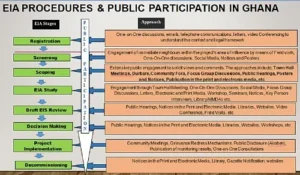Back to: Environmental Biology 400 Level
Welcome to class!
Imagine someone building a power plant right next to your village without asking for your opinion. You’d likely feel left out, possibly worried—and rightly so. That’s why public participation is a vital part of the Environmental Impact Assessment (EIA) process. It ensures that the voices of the people who live, work, and depend on an area are heard before any major project takes place.
Public Participation And Consultation In EIA
What is Public Participation in EIA?
Public participation is the process by which individuals, communities, interest groups, NGOs, and other stakeholders are given an opportunity to be involved in environmental decision-making. It allows those likely to be affected by a project to express their concerns, ask questions, and contribute to the development of sustainable solutions.

It is not just about listening to the public—it is about genuinely involving them in shaping the outcome of the project in a way that balances development with environmental and social responsibility.
Importance of Public Participation
Promotes transparency and accountability in project planning
Builds trust between developers and communities
Leads to better, more socially acceptable project designs
Helps uncover local knowledge that may not be obvious to technical experts
Reduces the likelihood of conflict, delays, or project failure due to public opposition
Stages of Public Participation in EIA
Screening and Scoping Phase
At this stage, local communities help identify what potential impacts to investigate. For example, if a cement factory is being proposed in Kogi State, farmers might express concerns about dust harming their crops.
EIA Report Preparation

Public inputs can shape how the environmental assessment is conducted. Community members can provide data, report changes in seasons or water flow, and suggest local solutions.
Review and Decision-Making
Stakeholders can review the draft EIA report and submit comments. In Nigeria, the Federal Ministry of Environment often holds public hearings where developers must respond to public concerns.
Implementation and Monitoring
Communities may also take part in monitoring the project’s environmental performance after approval, ensuring promised safeguards are actually followed.
Methods of Public Consultation
Public hearings and town hall meetings
Community workshops and focus group discussions
Use of local media and notice boards for announcements
Surveys and interviews
Involvement of community leaders and traditional rulers
Challenges in Nigeria
Low awareness of EIA processes in rural areas
Limited access to information and technical documents
Power imbalance between communities and project sponsors
Poorly organised or rushed consultation processes
Nigerian Example: Zungeru Hydroelectric Power Project

In Niger State, local communities were consulted through public meetings during the EIA process. Their input led to the relocation of some parts of the project, compensation plans, and resettlement strategies that reduced resistance and improved project acceptance.
Summary
- Public participation ensures that community voices are considered in environmental decisions.
- It is important for transparency, trust, local knowledge, and conflict prevention.
- It occurs at several stages—screening, assessment, review, and monitoring.
- Common methods include town halls, surveys, and community engagement.
- The Zungeru Power Project is a key example of successful public consultation in Nigeria.
Evaluation
- What is public participation in the context of EIA?
- Why is it important to involve the public in environmental decision-making?
- Mention three methods used for public consultation.
- At what stage of the EIA process does public input begin?
- Give one Nigerian example where public consultation influenced a project.
You’re doing an incredible job! As you learn about how the environment and people connect, you’re also preparing to become a thoughtful, responsible leader. Keep pushing forward—Afrilearn believes in your ability to make a lasting difference.
